 W
WPlay is a range of intrinsically motivated activities done for recreational pleasure and enjoyment. Play is commonly associated with children and juvenile-level activities, but play occurs at any life stage, and among other higher-functioning animals as well, most notably mammals and birds.
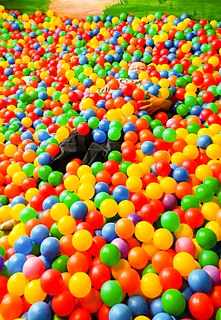 W
WA ball pit is a padded box or pool filled with small colorful hollow plastic balls generally no larger than 3 inches (7.6 cm) in diameter. They are typically marketed as recreation and exercise for children.
 W
WCat exercise wheel is a large wheel that a cat either runs on or walks on for exercise or play. A cat wheel looks like a large hamster wheel: the wheel turns from the weight of the cat. A wheel can be used for enrichment or to exercise high energy indoor cats.
 W
WCat play and toys incorporates predatory games of "play aggression." Cats' behaviors when playing are similar to hunting behaviors. These activities allow kittens and younger cats to grow and acquire cognitive and motor skills, and to socialize with other cats. Cat play behavior can be either solitary or social. They can play with a multitude of toys ranging from strings, to small furry toys resembling prey, to plastic bags.
 W
WCock and ball torture (CBT), occasionally known as penis torture, dick torture, or male genitorture/male genital torture, is a sexual activity involving the application of pain or constriction to the penis or testicles. This may involve directly painful activities, such as genital piercing, wax play, genital spanking, squeezing, ball-busting, genital flogging, urethral play, tickle torture, erotic electrostimulation, kneeing or kicking. The recipient of such activities may receive direct physical pleasure via masochism, or emotional pleasure through erotic humiliation, or knowledge that the play is pleasing to a sadistic dominant. Many of these practices carry significant health risks.
 W
WA doll is a model typically of a human or humanoid character, traditionally used as a toy for young girls. Dolls have also been used in religious rituals throughout the world. Traditional dolls made of materials such as clay and wood are found in the Americas, Asia, Africa and Europe. The earliest documented dolls go back to the ancient civilizations of Egypt, Greece, and Rome. They have been made as crude, rudimentary playthings as well as elaborate art. Modern doll manufacturing has its roots in Germany, from the 15th century. With industrialization and new materials such as porcelain and plastic, dolls were increasingly mass-produced. During the 20th century, dolls became increasingly popular as prized, antiques and collectibles.
 W
WGames People Play: The Psychology of Human Relationships is a bestselling 1964 book by psychiatrist Eric Berne. Since its publication it has sold more than five million copies. The book describes both functional and dysfunctional social interactions.
 W
WHomo Ludens is a book originally published in Dutch in 1938 by Dutch historian and cultural theorist Johan Huizinga. It discusses the importance of the play element of culture and society. Huizinga suggests that play is primary to and a necessary condition of the generation of culture. The Latin word ludens is the present active participle of the verb ludere, which itself is cognate with the noun ludus. Ludus has no direct equivalent in English, as it simultaneously refers to sport, play, school, and practice.
 W
Wi.play, also known as the Intelligent Play System is an interactive playground designed in collaboration between Progressive Sports Technologies Ltd and Playdale Playgrounds.
 W
WInflatable castles are temporary inflatable structures and buildings and similar items that are rented for functions, school and church festivals and village fetes and used for recreational purposes, particularly for children. The growth in the use of such devices has led to a rental industry that includes inflatable slides, obstacle courses, and games. Inflatables are ideal for portable amusements because they are easy to transport and store.
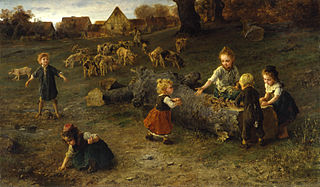 W
WMaking a mud pie is a children's activity or game that consists of creating a mixture of water and soil and playing or pretending to make food or a pie. Mud pies are not meant to be eaten, although they can be thrown in the face. A broader category describes this activity as mud play.
 W
WParallel play is a form of play in which children play adjacent to each other, but do not try to influence one another's behavior. Children usually play alone during parallel play but are interested in what other children are doing. This usually occurs after the first birthday. It usually involves two or more children in the same room who are interested in the same toy, each seeing the toy as their own. The children do not play together, but alongside each other simply because they are in the same room. Parallel play is usually first observed in children aged 2–3. An observer will notice that the children occasionally see what the others are doing and then modify their play accordingly. The older the children are, the less frequently they engage in this type of play. However, even older preschool children engage in parallel play, an enduring and frequent activity over the preschool years. The image of parallel play is two children playing side by side in a sandbox, each absorbed in his or her game, not interacting with the other. "This is considered an early stage in child development, characterized by egocentric behavior and the inability to decenter and coordinate with the activities of a 'playmate'".
 W
WA playpen is a piece of furniture in which an infant or young toddler is placed to prevent self-harm when her/his parent or guardian is occupied or away. The earliest use of the word "playpen" cited in the Oxford English Dictionary is 1902.
 W
WA petting zoo features a combination of domesticated animals and some wild species that are docile enough to touch and feed. In addition to independent petting zoos, many general zoos contain a petting zoo.
 W
WPlanking is an activity consisting of lying in a face down position, sometimes in an unusual or incongruous location. The palms of the hands are typically touching the sides of the body and the toes are typically touching the ground. Some players compete to find the most unusual and original location in which to play. The term planking refers to mimicking a wooden plank. Planking can include lying flat on a flat surface, or holding the body flat while it is supported in only some regions, with other parts of the body suspended. Many participants in planking have photographed the activity in unusual locations and have shared such pictures through social media.
 W
WA play bus is a bus used for providing a mobile facility for a variety of activities surrounding entertainment and education, usually for children of pre-school or school age.
 W
WPlay date or playdate is an expression primarily used in the US for an arranged appointment for children to get together for a few hours to play. It should not be confused with dating as there is not an implied romantic component to it.
 W
WPlay drive is a philosophical concept developed by Friedrich Schiller It is a conjoining, through contradiction, of the human experience of the infinite and finite, of freedom and time, of sense and reason, and of life and form.
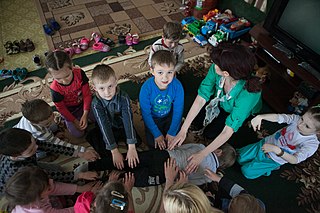 W
WPlay therapy refers to a range of methods of capitalising on children's natural urge to explore and harnessing it to meet and respond to the developmental and later also their mental health needs. It is also used for forensic or psychological assessment purposes where the individual is too young or too traumatised to give a verbal account of adverse, abusive or potentially criminal circumstances in their life.
 W
WPlay is a range of intrinsically motivated activities done for recreational pleasure and enjoyment. Play is commonly associated with children and juvenile-level activities, but play occurs at any life stage, and among other higher-functioning animals as well, most notably mammals and birds.
 W
WPlay is a range of intrinsically motivated activities done for recreational pleasure and enjoyment. Play is commonly associated with children and juvenile-level activities, but play occurs at any life stage, and among other higher-functioning animals as well, most notably mammals and birds.
 W
WA playground, playpark, or play area is a place designed to provide an environment for children that facilitates play, typically outdoors. While a playground is usually designed for children, some are designed for other age groups, or people with disabilities. A playground might exclude children below a certain age.
 W
WA playground parachute is a round, multicolored, nylon sheet commonly 20 to 30 feet in diameter. It may or may not have handles on the periphery. It is used by arranging children on the outside, who then vigorously wave the parachute up and down. Playground parachutes are commonly used in kindergarten and early elementary school physical education classes, gymnastics classes, and organized recess, but is aimed for people of all ages.
 W
WPlayground slides are found in parks, schools, playgrounds and backyards. The slide is an example of the simple machine known as the inclined plane, which makes moving objects up and down easier, or in this case more fun. The slide may be flat, or half cylindrical or tubular to prevent falls. Slides are usually constructed of plastic or metal and they have a smooth surface that is either straight or wavy. The user, typically a child, climbs to the top of the slide via a ladder or stairs and sits down on the top of the slide and slides down the chute.
 W
WRecess is a general term for a period in which a group of people are temporarily dismissed from their duties.
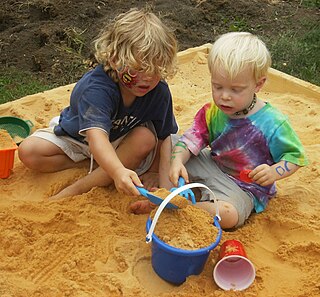 W
WA sandpit or sandbox is a low, wide container or shallow depression filled with soft (beach) sand in which children can play. Sharp sand is not suitable for such use. Many homeowners with children build sandpits in their backyards because, unlike most playground equipment, they can be easily and cheaply constructed.
 W
WA snow angel is a design, made in fresh snow, by lying on one's back and moving one's arms up and down, and one's legs from side to side, to form the shape of an angel. Making snow angels is a common childhood game.
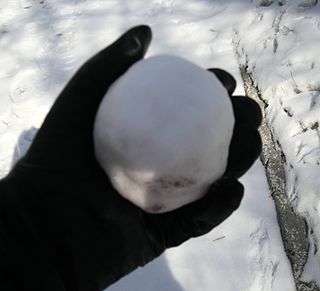 W
WA snowball is a spherical object made from snow, usually created by scooping snow with the hands, and pressing the snow together to compact it into a ball. Snowballs are often used in games such as snowball fights.
 W
WA snowball fight is a physical game in which balls of snow are thrown with the intention of hitting somebody else. The game is similar to dodgeball in its major factors, though typically less organized. This activity is primarily played during winter when there is sufficient snowfall.
 W
WA snowman is an anthropomorphic snow sculpture often built in regions with sufficient snowfall. In many places, typical snowmen consist of three large snowballs of different sizes with some additional accoutrements for facial and other features. Due to the sculptability of snow, there is also a wide variety of other styles. Common accessories include branches for arms and a rudimentary smiley face, with a carrot used for a nose. Clothing, such as a hat or scarf, may be included. The low cost and availability of materials mean snowmen are usually abandoned once completed.
 W
WBrian Sutton Smith, better known as Brian Sutton-Smith, was a play theorist who spent his lifetime attempting to discover the cultural significance of play in human life, arguing that any useful definition of play must apply to both adults and children. He demonstrated that children are not innocent in their play and that adults are indeed guilty in theirs. In both cases play pretends to assist them in surmounting their Darwinian struggles for survival. His book Play As Emotional Survival is a response to his own deconstruction of play theories in his work, The Ambiguity of Play.
 W
WThe Association for the Study of Play (TASP) is a multidisciplinary organization of scholars and practitioners in the field of play. The Association promotes the study of play, forges alliances with organizations advancing play, organizes yearly meetings to disseminate play research, and publishes a newsletter and monograph series.
 W
WA toy is an item that is used in play, especially one designed for such use. It is mainly intended for use by children, though may also be marketed to adults under certain circumstances. Playing with toys can be an enjoyable means of training young children for life in society. Different materials like wood, clay, paper, and plastic are used to make toys. Many items are designed to serve as toys, but goods produced for other purposes can also be used. For instance, a small child may fold an ordinary piece of paper into an airplane shape and "fly it". Newer forms of toys include interactive digital entertainment. Some toys are produced primarily as collectors' items and are intended for display only.
 W
WTwirling is a form of object manipulation where an object is twirled by one or two hands, the fingers or by other parts of the body. Twirling practice manipulates the object in circular or near circular patterns. It can also be done indirectly by the use of another object or objects as in the case of devil stick manipulation where handsticks are used. Twirling is performed as a hobby, sport, exercise or performance.
 W
WWorldwide Day of Play is an annual event designed to encourage children and parents to turn off the television and play together, especially outdoors. The yearly event officially began on October 2, 2004, and has been broadcast on all US Nickelodeon channels: Nickelodeon, Nick GAS, Noggin, The N, Nicktoons, Nick Jr. and NickMusic. The event is designed as a finale for Nick's six-month-long Let's Just Play campaign. In addition, Nick.com would also have special features for children to learn how to stay active and healthy.